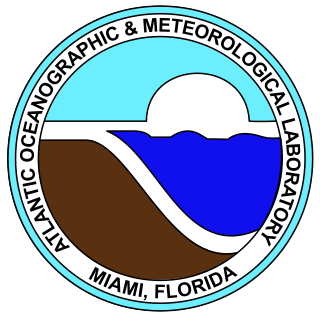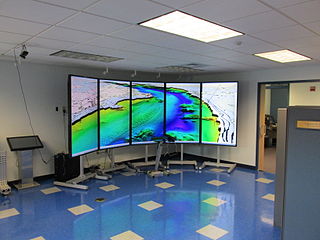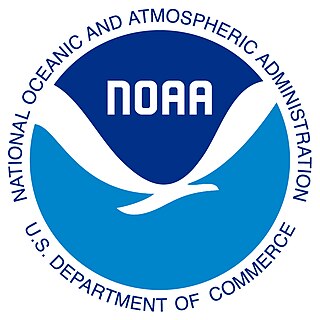
The National Oceanic and Atmospheric Administration is an American scientific and regulatory agency charged with forecasting weather, monitoring oceanic and atmospheric conditions, charting the seas, conducting deep-sea exploration, and managing fishing and protection of marine mammals and endangered species in the US exclusive economic zone. The agency is part of the United States Department of Commerce and is headquartered in Silver Spring, Maryland.
This is a list of meteorology topics. The terms relate to meteorology, the interdisciplinary scientific study of the atmosphere that focuses on weather processes and forecasting.

Oceanic and Atmospheric Research (OAR) is a division of the National Oceanic and Atmospheric Administration (NOAA). OAR is also referred to as NOAA Research.
The Arctic Research Office (ARO) a division of the National Oceanic and Atmospheric Administration (NOAA) run under the auspices of the Office of Oceanic and Atmospheric Research (OAR).

The Atlantic Oceanographic and Meteorological Laboratory (AOML), a federal research laboratory, is part of the National Oceanic and Atmospheric Administration's (NOAA) Office of Oceanic and Atmospheric Research (OAR), located in Miami in the United States. AOML's research spans tropical cyclone and hurricanes, coastal ecosystems, oceans and human health, climate studies, global carbon systems, and ocean observations. It is one of seven NOAA Research Laboratories (RLs).

The Cooperative Institute for Arctic Research was a research institute created via collaboration between the National Oceanic and Atmospheric Administration (NOAA) and The Office of Oceanic and Atmospheric Research (OAR) and the Arctic research community through the University of Alaska for research related to the Western Arctic, specifically the Bering Sea region. The institute dissolved in 2018 due to a discontinuation in funding.
The Cooperative Institute for Climate Applications and Research (CICAR) was a major collaborative relationship between the National Oceanic and Atmospheric Administration (NOAA) Office of Oceanic and Atmospheric Research (OAR) and Earth Institute, Columbia University.

The Cooperative Institute for Great Lakes Research, formerly known as the Cooperative Institute for Limnology and Ecosystems Research, fosters research collaborations between the National Oceanic and Atmospheric Administration (NOAA) Office of Oceanic and Atmospheric Research (OAR) Great Lakes Environmental Research Laboratory (GLERL), Michigan State University (MSU), and the University of Michigan (UM). It is one of 16 NOAA Cooperative Institutes (CIs).
The Cooperative Institute for Marine and Atmospheric Studies (CIMAS) is a research institute of the University of Miami located in its Rosenstiel School of Marine, Atmospheric, and Earth Science (RSMAS) in Miami, Florida.
The Cooperative Institute for Severe and High-Impact Weather Research and Operations (CIWRO) is one of 16 NOAA Cooperative Institutes (CIs), hosted at the University of Oklahoma. Before Oct. 1, 2021, it was known as the Cooperative Institute for Mesoscale Meteorological Studies (CIMMS). The CIMMS/CIWRO, a research organization created in 1978 by a cooperative agreement between the University of Oklahoma (OU) and the National Oceanic and Atmospheric Administration (NOAA), promotes collaborative research between NOAA and OU scientists on problems of mutual interest to improve basic understanding of mesoscale meteorological phenomena, weather radar, and regional climate to help produce better forecasts and warnings that save lives and property. CIMMS/CIWRO research contributes to the NOAA mission through improvement of the observation, analysis, understanding, and prediction of weather elements and systems and climate anomalies ranging in size from cloud nuclei to multi-state areas.
The Cooperative Institute for Research in the Atmosphere (CIRA) is a scientific research institution at Colorado State University (CSU) that operates under a cooperative agreement with the National Oceanic and Atmospheric Administration (NOAA) Office of Oceanic and Atmospheric Research (OAR) and the National Environmental Satellite, Data, and Information Service (NESDIS). Atmospheric research at CIRA focuses on augmenting operational meteorology with advanced techniques in satellite observations and retrievals, numerical modeling and computational techniques, and data analysis, visualization, and storage. Along with NOAA, CIRA also partners with the National Science Foundation (NSF), the National Aeronautics and Space Administration (NASA), the National Park Service (NPS), and the Department of Defense (DoD).

The Cooperative Institute for Research in Environmental Sciences (CIRES) is a research institute that is sponsored jointly by the National Oceanic and Atmospheric Administration (NOAA) Office of Oceanic and Atmospheric Research (OAR) and the University of Colorado Boulder (CU). CIRES scientists study the Earth system, including the atmosphere, hydrosphere, cryosphere, biosphere, and geosphere, and communicate these findings to decision makers, the scientific community, and the public.
The Cooperative Institute for Marine and Atmospheric Research(CIMAR) is an oceanic, atmospheric, and geophysical research institute that is sponsored jointly by the National Oceanic and Atmospheric Administration (NOAA) Office of Oceanic and Atmospheric Research (OAR) and the University of Hawaiʻi (UH). Formerly incorporated as JIMAR (Joint Institute for Marine and Atmospheric Research), it is one of 21 NOAA Cooperative Institutes (CIs).
The Cooperative Institute for Climate, Ocean, and Ecosystem Studies (CICOES), formerly known as the Joint Institute for the Study of the Atmosphere and Ocean (JISAO), has existed since 1977 for the purpose of fostering research collaboration between National Oceanic and Atmospheric Administration (NOAA) Office of Oceanic and Atmospheric Research (OAR) and the University of Washington (UW). Dr. John K. Horne is the current director.

The Earth System Research Laboratories (ESRL) is an alliance of four NOAA scientific labs, all located in the David Skaggs Research Center on the Department of Commerce campus in Boulder, Colorado. Organized under NOAA's Office of Oceanic and Atmospheric Research, ESRL's main goal is to advance the scientific understanding of weather, climate, air quality, water resources, and other Earth system components.
The Cooperative Institute for Meteorological Satellite Studies (CIMSS) is a research institute where scientists study the use of data from geostationary and polar orbit weather satellites to improve forecasts of weather (including tropical cyclones and severe storms. CIMSS was formed through a Memorandum of Understanding between the University of Wisconsin–Madison, the National Oceanic and Atmospheric Administration and the National Aeronautics and Space Administration. CIMSS parent organization, the Space Science and Engineering Center is a primary developer and operator of environmental satellite technologies.

The under secretary of commerce for oceans and atmosphere, or USC(OA), is a high-ranking official in the United States Department of Commerce and the principal advisor to the United States secretary of commerce on the environmental and scientific activities of the department. The under secretary is dual hatted as the administrator of the National Oceanic and Atmospheric Administration within the Commerce Department.

The Northern Gulf Institute (NGI) is a National Oceanic and Atmospheric Administration (NOAA) Cooperative Institute started in October 2006. It is one of 20 NOAA Cooperative Institutes (CIs). The NGI is a partnership of six academic institutions and NOAA. The collaboration led by Mississippi State University (MSU), includes the University of Southern Mississippi (USM), Louisiana State University (LSU), Florida State University (FSU), the University of Alabama in Huntsville, and the Dauphin Island Sea Lab (DISL). The NGI defines the Northern Gulf of Mexico region as the upland, watershed, coastal zone, and coastal ocean areas from the Sabine River in Louisiana east to the Suwannee River in Florida.

The Center for Coastal and Ocean Mapping (CCOM) / NOAA-UNH Joint Hydrographic Center (JHC) was founded in 2000 by Dr. Larry Mayer to find ways to process the massive amounts of data coming from sonar systems at rates commensurate with data collection; that is, to make the data ready for chart production as rapidly as the data could be collected.

The National Centers for Environmental Information (NCEI) is a U.S. government agency that manages one of the world's largest archives of atmospheric, coastal, geophysical, and oceanic data. The current director is Deke Arndt.









